2008 BMW MOTORRAD K 1200 R brakes
[x] Cancel search: brakesPage 66 of 165
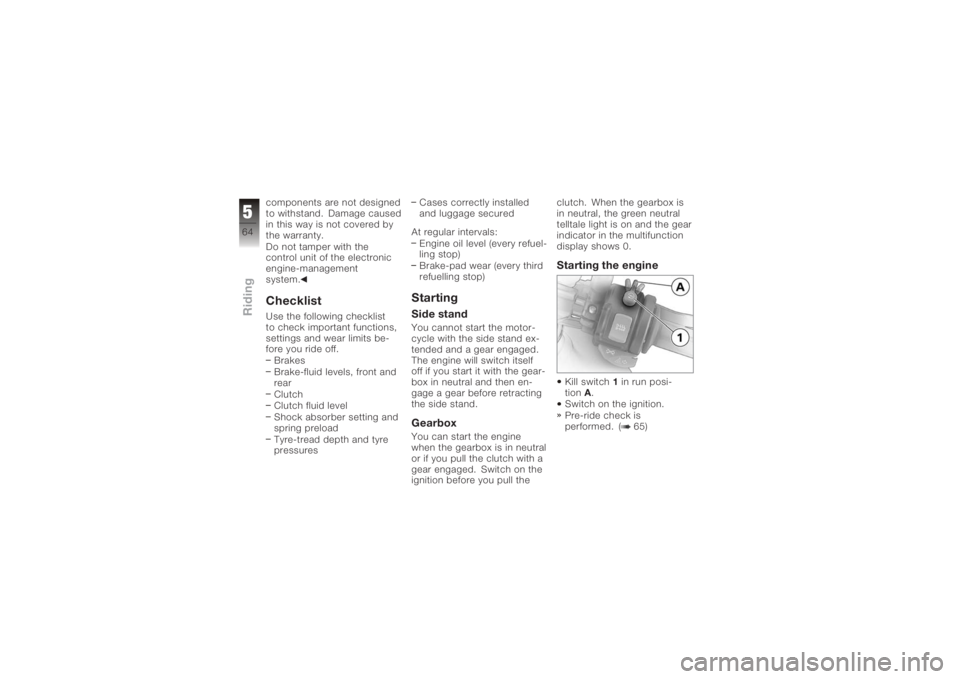
components are not designed
to withstand. Damage caused
in this way is not covered by
the warranty.
Do not tamper with the
control unit of the electronic
engine-management
system.ChecklistUse the following checklist
to check important functions,
settings and wear limits be-
fore you ride off.Brakes
Brake-fluid levels, front and
rear
Clutch
Clutch fluid level
Shock absorber setting and
spring preload
Tyre-tread depth and tyre
pressures Cases correctly installed
and luggage secured
At regular intervals: Engine oil level (every refuel-
ling stop)
Brake-pad wear (every third
refuelling stop)
StartingSide standYou cannot start the motor-
cycle with the side stand ex-
tended and a gear engaged.
The engine will switch itself
off if you start it with the gear-
box in neutral and then en-
gage a gear before retracting
the side stand.GearboxYou can start the engine
when the gearbox is in neutral
or if you pull the clutch with a
gear engaged. Switch on the
ignition before you pull the clutch. When the gearbox is
in neutral, the green neutral
telltale light is on and the gear
indicator in the multifunction
display shows 0.
Starting the engineKill switch
1in run posi-
tion A.
Switch on the ignition.
Pre-ride check is
performed. ( 65)
564zRiding
Page 67 of 165
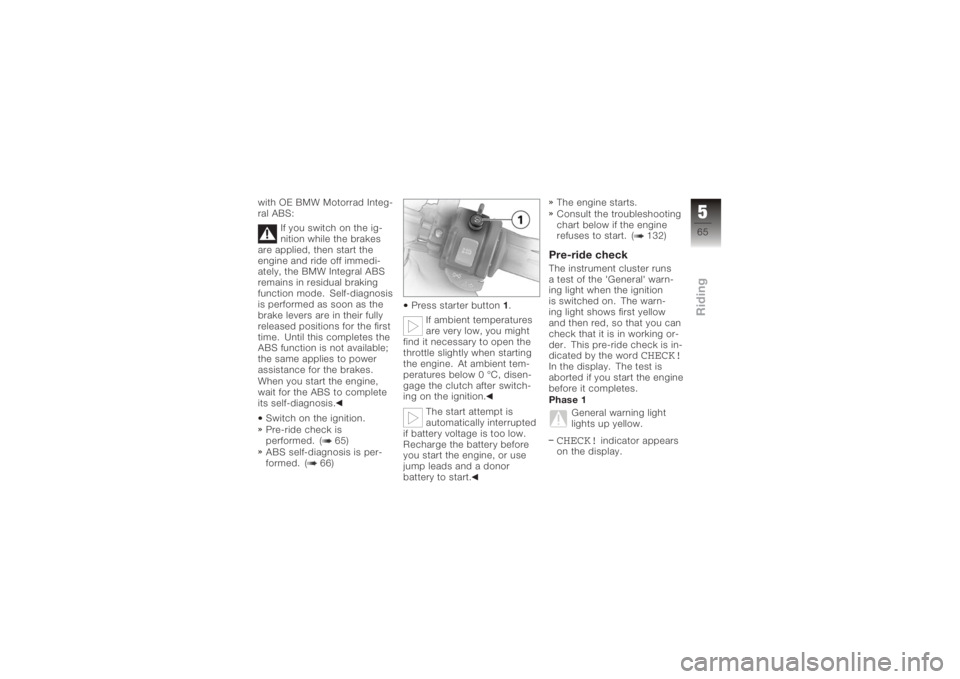
with OE BMW Motorrad Integ-
ral ABS:If you switch on the ig-
nition while the brakes
are applied, then start the
engine and ride off immedi-
ately, the BMW Integral ABS
remains in residual braking
function mode. Self-diagnosis
is performed as soon as the
brake levers are in their fully
released positions for the first
time. Until this completes the
ABS function is not available;
the same applies to power
assistance for the brakes.
When you start the engine,
wait for the ABS to complete
its self-diagnosis.
Switch on the ignition.
Pre-ride check is
performed. ( 65)
ABS self-diagnosis is per-
formed. ( 66) Press starter button
1.
If ambient temperatures
are very low, you might
find it necessary to open the
throttle slightly when starting
the engine. At ambient tem-
peratures below 0 °C, disen-
gage the clutch after switch-
ing on the ignition.
The start attempt is
automatically interrupted
if battery voltage is too low.
Recharge the battery before
you start the engine, or use
jump leads and a donor
battery to start. The engine starts.
Consult the troubleshooting
chart below if the engine
refuses to start. ( 132)
Pre-ride checkThe instrument cluster runs
a test of the 'General' warn-
ing light when the ignition
is switched on. The warn-
ing light shows first yellow
and then red, so that you can
check that it is in working or-
der. This pre-ride check is in-
dicated by the word
CHECK!
In the display. The test is
aborted if you start the engine
before it completes.
Phase 1
General warning light
lights up yellow.CHECK!
indicator appears
on the display.
565zRiding
Page 69 of 165
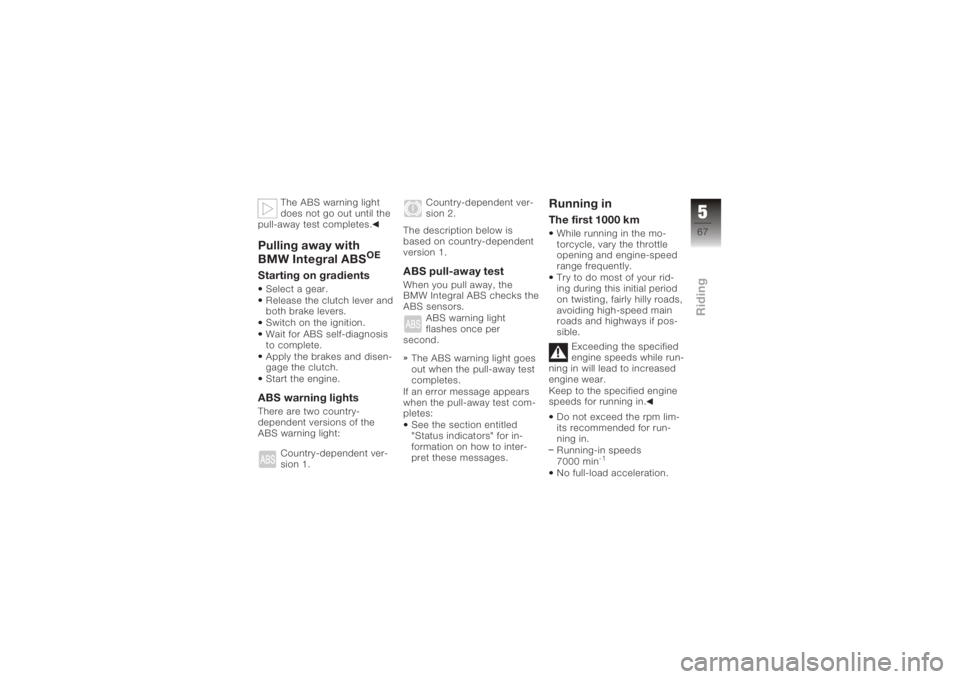
The ABS warning light
does not go out until the
pull-away test completes.
Pulling away with
BMW Integral ABS
OE
Starting on gradientsSelect a gear.
Release the clutch lever and
both brake levers.
Switch on the ignition.
Wait for ABS self-diagnosis
to complete.
Apply the brakes and disen-
gage the clutch.
Start the engine.ABS warning lightsThere are two country-
dependent versions of the
ABS warning light:
Country-dependent ver-
sion 1. Country-dependent ver-
sion 2.
The description below is
based on country-dependent
version 1.
ABS pull-away testWhen you pull away, the
BMW Integral ABS checks the
ABS sensors. ABS warning light
flashes once per
second.
The ABS warning light goes
out when the pull-away test
completes.
If an error message appears
when the pull-away test com-
pletes: See the section entitled
"Status indicators" for in-
formation on how to inter-
pret these messages.
Running inThe first 1000 kmWhile running in the mo-
torcycle, vary the throttle
opening and engine-speed
range frequently.
Try to do most of your rid-
ing during this initial period
on twisting, fairly hilly roads,
avoiding high-speed main
roads and highways if pos-
sible.
Exceeding the specified
engine speeds while run-
ning in will lead to increased
engine wear.
Keep to the specified engine
speeds for running in.
Do not exceed the rpm lim-
its recommended for run-
ning in.
Running-in speeds
7000 min
-1
No full-load acceleration.
567zRiding
Page 70 of 165
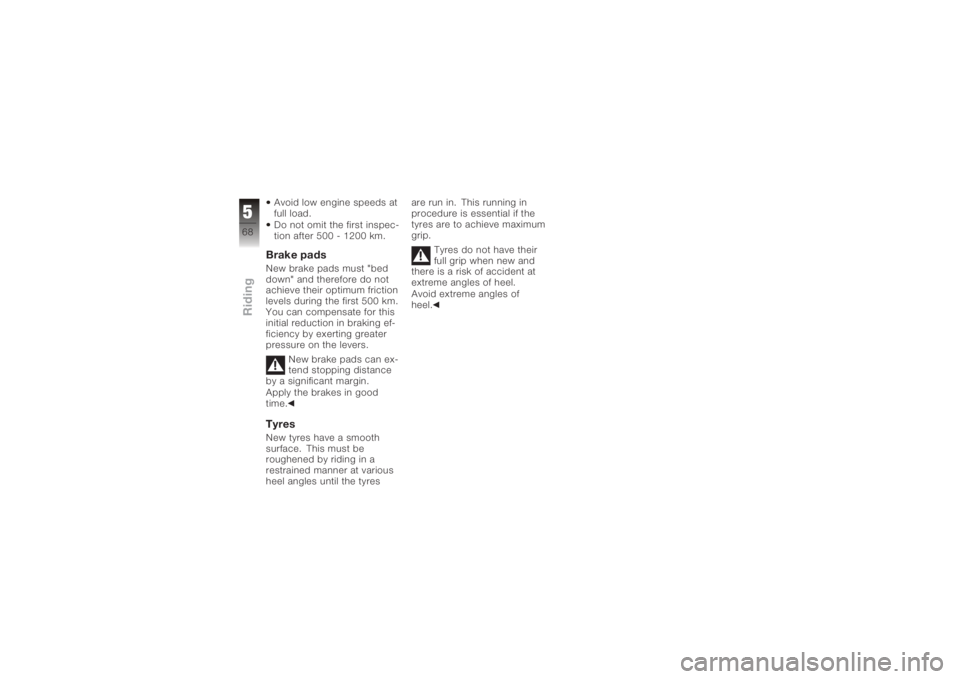
Avoid low engine speeds at
full load.
Do not omit the first inspec-
tion after 500 - 1200 km.Brake padsNew brake pads must "bed
down" and therefore do not
achieve their optimum friction
levels during the first 500 km.
You can compensate for this
initial reduction in braking ef-
ficiency by exerting greater
pressure on the levers.New brake pads can ex-
tend stopping distance
by a significant margin.
Apply the brakes in good
time.TyresNew tyres have a smooth
surface. This must be
roughened by riding in a
restrained manner at various
heel angles until the tyres are run in. This running in
procedure is essential if the
tyres are to achieve maximum
grip.
Tyres do not have their
full grip when new and
there is a risk of accident at
extreme angles of heel.
Avoid extreme angles of
heel.
568zRiding
Page 81 of 165
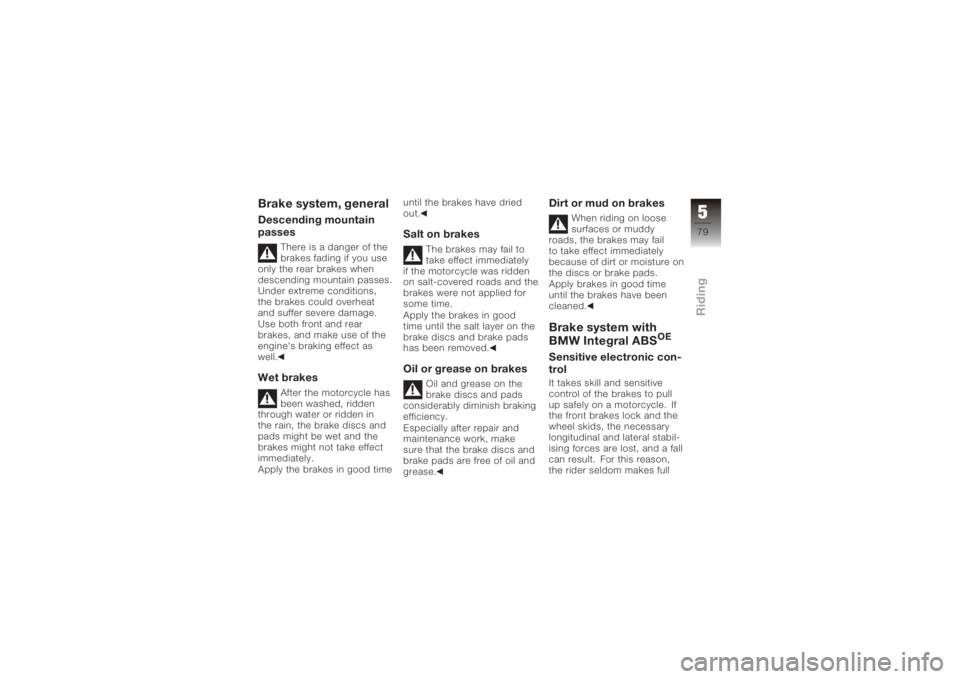
Brake system, generalDescending mountain
passes
There is a danger of the
brakes fading if you use
only the rear brakes when
descending mountain passes.
Under extreme conditions,
the brakes could overheat
and suffer severe damage.
Use both front and rear
brakes, and make use of the
engine's braking effect as
well.
Wet brakes
After the motorcycle has
been washed, ridden
through water or ridden in
the rain, the brake discs and
pads might be wet and the
brakes might not take effect
immediately.
Apply the brakes in good time until the brakes have dried
out.
Salt on brakes
The brakes may fail to
take effect immediately
if the motorcycle was ridden
on salt-covered roads and the
brakes were not applied for
some time.
Apply the brakes in good
time until the salt layer on the
brake discs and brake pads
has been removed.
Oil or grease on brakes
Oil and grease on the
brake discs and pads
considerably diminish braking
efficiency.
Especially after repair and
maintenance work, make
sure that the brake discs and
brake pads are free of oil and
grease.
Dirt or mud on brakes
When riding on loose
surfaces or muddy
roads, the brakes may fail
to take effect immediately
because of dirt or moisture on
the discs or brake pads.
Apply brakes in good time
until the brakes have been
cleaned.
Brake system with
BMW Integral ABS
OE
Sensitive electronic con-
trolIt takes skill and sensitive
control of the brakes to pull
up safely on a motorcycle. If
the front brakes lock and the
wheel skids, the necessary
longitudinal and lateral stabil-
ising forces are lost, and a fall
can result. For this reason,
the rider seldom makes full
579zRiding
Page 82 of 165
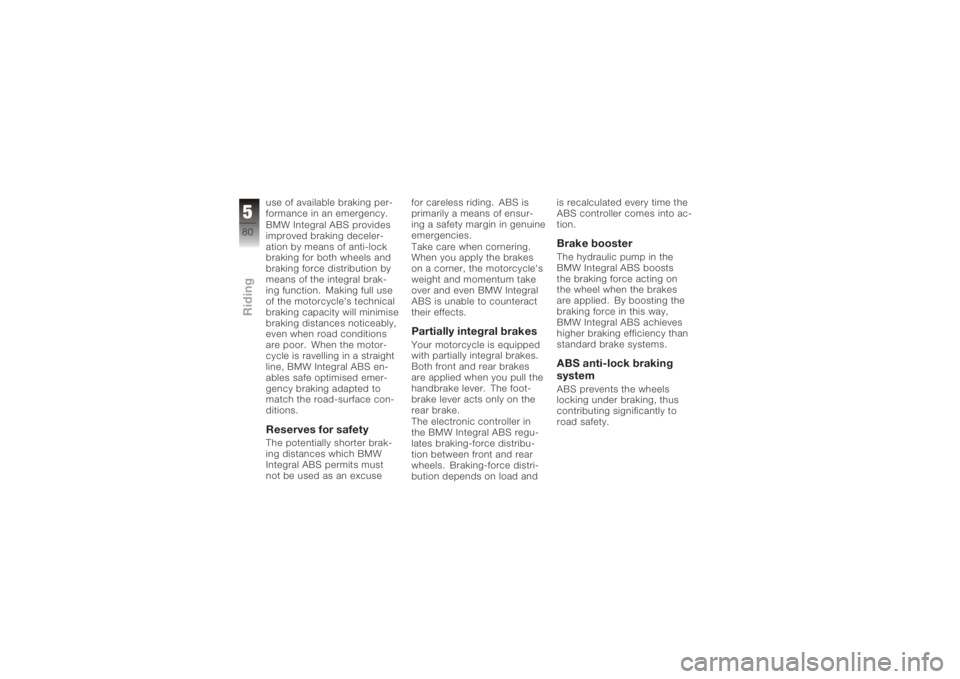
use of available braking per-
formance in an emergency.
BMW Integral ABS provides
improved braking deceler-
ation by means of anti-lock
braking for both wheels and
braking force distribution by
means of the integral brak-
ing function. Making full use
of the motorcycle's technical
braking capacity will minimise
braking distances noticeably,
even when road conditions
are poor. When the motor-
cycle is ravelling in a straight
line, BMW Integral ABS en-
ables safe optimised emer-
gency braking adapted to
match the road-surface con-
ditions.Reserves for safetyThe potentially shorter brak-
ing distances which BMW
Integral ABS permits must
not be used as an excusefor careless riding. ABS is
primarily a means of ensur-
ing a safety margin in genuine
emergencies.
Take care when cornering.
When you apply the brakes
on a corner, the motorcycle's
weight and momentum take
over and even BMW Integral
ABS is unable to counteract
their effects.
Partially integral brakesYour motorcycle is equipped
with partially integral brakes.
Both front and rear brakes
are applied when you pull the
handbrake lever. The foot-
brake lever acts only on the
rear brake.
The electronic controller in
the BMW Integral ABS regu-
lates braking-force distribu-
tion between front and rear
wheels. Braking-force distri-
bution depends on load andis recalculated every time the
ABS controller comes into ac-
tion.
Brake boosterThe hydraulic pump in the
BMW Integral ABS boosts
the braking force acting on
the wheel when the brakes
are applied. By boosting the
braking force in this way,
BMW Integral ABS achieves
higher braking efficiency than
standard brake systems.ABS anti-lock braking
systemABS prevents the wheels
locking under braking, thus
contributing significantly to
road safety.
580zRiding
Page 83 of 165
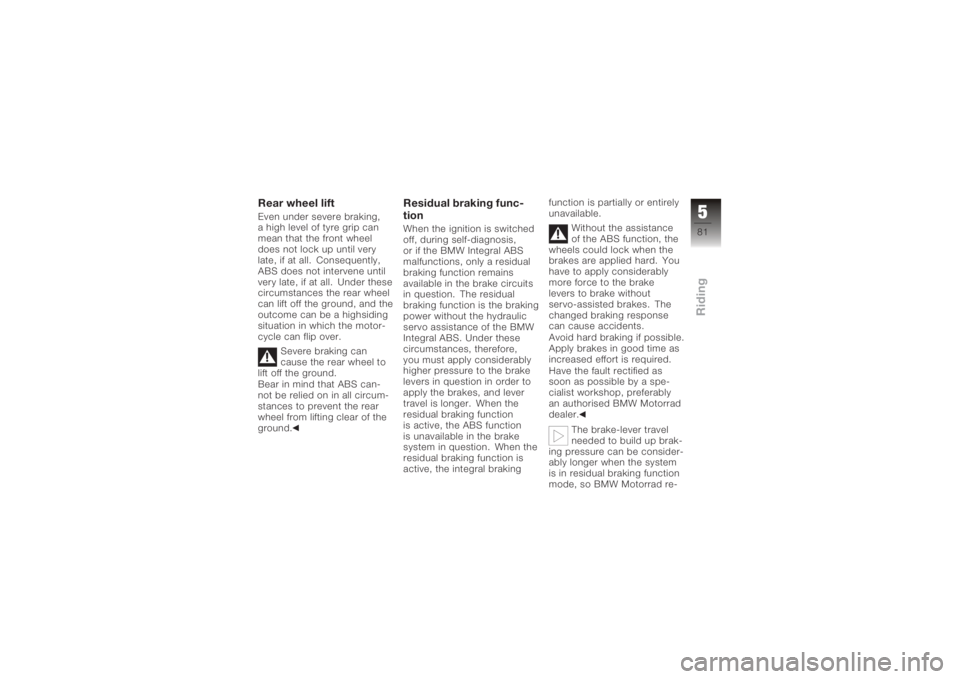
Rear wheel liftEven under severe braking,
a high level of tyre grip can
mean that the front wheel
does not lock up until very
late, if at all. Consequently,
ABS does not intervene until
very late, if at all. Under these
circumstances the rear wheel
can lift off the ground, and the
outcome can be a highsiding
situation in which the motor-
cycle can flip over.Severe braking can
cause the rear wheel to
lift off the ground.
Bear in mind that ABS can-
not be relied on in all circum-
stances to prevent the rear
wheel from lifting clear of the
ground.
Residual braking func-
tionWhen the ignition is switched
off, during self-diagnosis,
or if the BMW Integral ABS
malfunctions, only a residual
braking function remains
available in the brake circuits
in question. The residual
braking function is the braking
power without the hydraulic
servo assistance of the BMW
Integral ABS. Under these
circumstances, therefore,
you must apply considerably
higher pressure to the brake
levers in question in order to
apply the brakes, and lever
travel is longer. When the
residual braking function
is active, the ABS function
is unavailable in the brake
system in question. When the
residual braking function is
active, the integral braking function is partially or entirely
unavailable.
Without the assistance
of the ABS function, the
wheels could lock when the
brakes are applied hard. You
have to apply considerably
more force to the brake
levers to brake without
servo-assisted brakes. The
changed braking response
can cause accidents.
Avoid hard braking if possible.
Apply brakes in good time as
increased effort is required.
Have the fault rectified as
soon as possible by a spe-
cialist workshop, preferably
an authorised BMW Motorrad
dealer.
The brake-lever travel
needed to build up brak-
ing pressure can be consider-
ably longer when the system
is in residual braking function
mode, so BMW Motorrad re-
581zRiding
Page 97 of 165
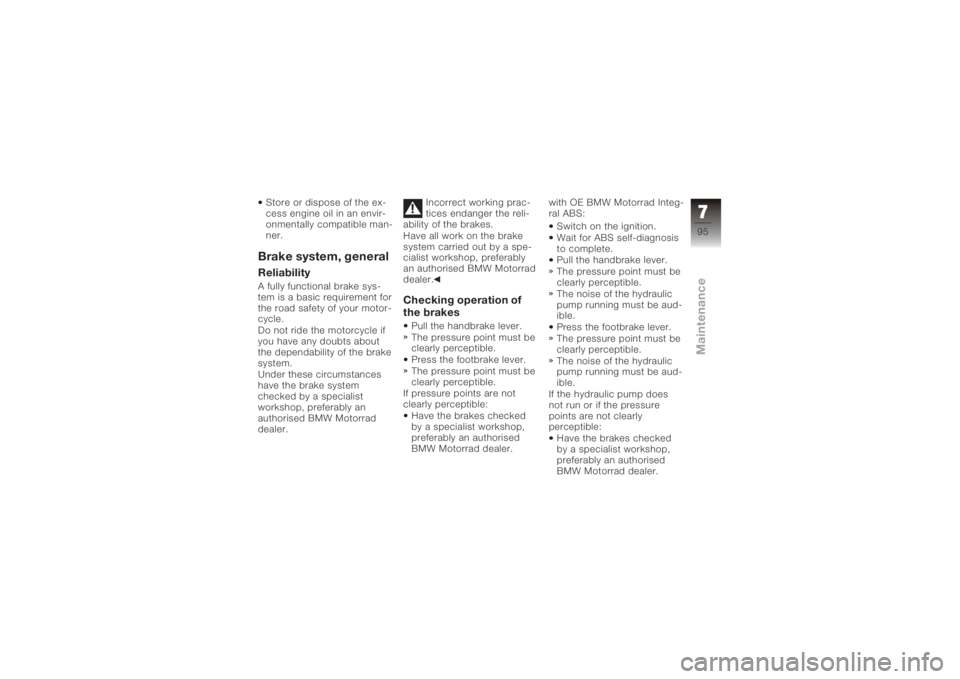
Store or dispose of the ex-
cess engine oil in an envir-
onmentally compatible man-
ner.Brake system, generalReliabilityA fully functional brake sys-
tem is a basic requirement for
the road safety of your motor-
cycle.
Do not ride the motorcycle if
you have any doubts about
the dependability of the brake
system.
Under these circumstances
have the brake system
checked by a specialist
workshop, preferably an
authorised BMW Motorrad
dealer.Incorrect working prac-
tices endanger the reli-
ability of the brakes.
Have all work on the brake
system carried out by a spe-
cialist workshop, preferably
an authorised BMW Motorrad
dealer.
Checking operation of
the brakesPull the handbrake lever.
The pressure point must be
clearly perceptible.
Press the footbrake lever.
The pressure point must be
clearly perceptible.
If pressure points are not
clearly perceptible: Have the brakes checked
by a specialist workshop,
preferably an authorised
BMW Motorrad dealer. with OE BMW Motorrad Integ-
ral ABS:
Switch on the ignition.
Wait for ABS self-diagnosis
to complete.
Pull the handbrake lever.
The pressure point must be
clearly perceptible.
The noise of the hydraulic
pump running must be aud-
ible.
Press the footbrake lever.
The pressure point must be
clearly perceptible.
The noise of the hydraulic
pump running must be aud-
ible.
If the hydraulic pump does
not run or if the pressure
points are not clearly
perceptible: Have the brakes checked
by a specialist workshop,
preferably an authorised
BMW Motorrad dealer.
795zMaintenance